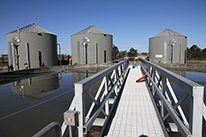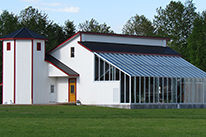
Le biogaz
Les effets néfastes sur la santé publique et sur le réchauffement climatique des émissions des carburants issus du pétrole sont bien connus et documentés. Or, on oublie trop souvent que 56 % de l’énergie que nous consommons au Québec consiste principalement de pétrole importé, ce qui affecte aussi négativement notre balance commerciale et notre économie.
Pourtant, il existe un carburant renouvelable, disponible en abondance et respectueux de l’environnement. Ce carburant, c’est le gaz naturel renouvelable (GNR) ou biométhane produit à partir du biogaz. Il alimente déjà des véhicules et des appareils qui fonctionneraient autrement avec des produits pétroliers.
Le biogaz est une source d'énergie renouvelable qui présente de nombreux avantages environnementaux. Contrairement à la combustion de produits pétroliers, le biogaz récupéré de la digestion organique est considéré comme étant CO2 neutre. Par le fait même, il ne contribue pas à l'augmentation des gaz à effet de serre. De plus, tout méthane non capté contribue 21 fois de plus à l'effet de serre que le CO2 relâché dans l'atmosphère par les énergies fossiles. Il est donc primordial de récupérer ce gaz pour le transformer en électricité ou en chaleur, réduisant du même coup notre dépendance au pétrole.
Le biogaz :
- est entièrement renouvelable et peut être produit localement. Il peut donc favoriser notre indépendance énergétique et la création d’emplois non délocalisables.
- produit 97% moins de CO2 que le diesel.
Les effets néfastes sur la santé publique et sur le réchauffement climatique des émissions des carburants issus du pétrole sont bien connus et documentés. Or, on oublie trop souvent que 56 % de l’énergie que nous consommons au Québec consiste principalement de pétrole importé, ce qui affecte aussi négativement notre balance commerciale et notre économie.
Pourtant, il existe un carburant renouvelable, disponible en abondance et respectueux de l’environnement. Ce carburant, c’est le gaz naturel renouvelable (GNR) ou biométhane produit à partir du biogaz. Il alimente déjà des véhicules et des appareils qui fonctionneraient autrement avec des produits pétroliers.
Le processus de fabrication du biogaz fait appel à des matières organiques que nous produisons en grande quantité : déchets industriels ou agricoles, ordures ménagères, boues de stations d’épuration des eaux. La biodégradation de ces matières en absence d'oxygène, la méthanisation, permet d’obtenir du digestat et du biogaz.
On valorise le GNR par injection dans le réseau gazier, et le digestat en l’utilisant comme matière fertilisante en agriculture ou en aménagement paysager. Le biogaz est un carburant renouvelable et responsable qui peut aussi servir pour produire de l’eau chaude, de la vapeur ou de l’électricité.
Les avantages environnementaux et économiques du biogaz sont tels qu’il mérite qu’on lui accorde une plus grande place dans notre approvisionnement énergétique.
Le Québec compte déjà 14 sites de production.
sur notre chaine








